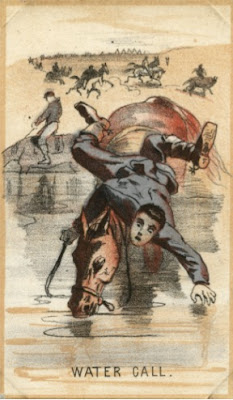Winslow Homer, an
American painter, is considered one of the greatest pioneer artists of the late
19th century. His paintings brought life and color to the American
wilderness for those who had never seen it, and his dramatic paintings of man
interacting with nature inspired countless landscape artists after him. His paintings
depicted daily life in the Americas, the Civil War, life on homesteads, the
Northeastern wilderness, and the rough Atlantics seas. A specialty of Homer’s
was to paint life “as it happened,” not just the stillness of a scene. This technique
makes his artwork more compelling than a typical landscape scene.
Homer was born in
Boston, Massachusetts in 1836. His mother was an amateur painter, and it was
she who first taught him the basics of painting. When he was a teenager, Homer found
work as a lithographer’s apprentice, where he further refined his drawing
skills. Eventually, he was able to attend the National Academy of Design in New
York, where he began submitting his artwork to Harper’s Weekly magazine.
Harper’s admired his talent, and when the Civil War
erupted in the American South, the magazine commissioned Homer to follow the
Union campaign across the nation and sketch military life. The drawings Homer created
during the war were later turned into paintings, and became realistic
recordings of life on the war front. Below are some of his sketches of the war.
 |
| Water Call, 1864. Lithographic card |
 |
| Surgeon’s Call, 1864. Lithographic card |
 |
| The Bright Side, 1865. Oil on canvas |
After the war, Homer returned to his New England roots. His subsequent paintings have a strong focus on man versus nature, and depict the powerful beauty of the wilderness surrounding humble subjects. In the majority of his later paintings, the contrast between the single subject and the vibrant scenery around him is evident. In paintings like the one below, the power of nature holds much of the viewer’s attention while the subject remains the center. This stark contrast of darks and lights aligns with Homer’s interest in the power of nature.
 |
| The Gulf Stream, 1899. Oil on canvas |
Throughout his
painting career, Homer used both oil and watercolor as mediums. At the time of
the Civil War, watercolor was viewed as an “amateur’s medium,” while oil was
seen as much more sophisticated. Winslow Homer is credited with the rise of
watercolor’s popularity as a professional medium, with his intricate forest and
river paintings done entirely in watercolor. In the painting below, Homer once
again uses color and light to contrast the power of the landscape with the
humble subject.
 |
| Old Friends, 1892. Watercolor |
I chose to study
Homer because I enjoy landscape paintings. Homer’s paintings are special to me
because of the way he uses color to portray the shadows and highlights of the
landscape. I also like that his paintings are very realistic and detailed,
which is something I hope to have in my artwork. I also enjoy working with
watercolor, and by studying his paintings I can learn new techniques for this
style.
Works Cited (MLA)
Greenhill, Jennifer A. “Winslow Homer and the Mechanics
of Visual Deadpan.” Art History, vol.
32, no. 2, Apr. 2009, pp. 351-386. EBSCOhost,
doi:10.1111/j.1467-8365.2009.00671.x.
Cole TB. The Bright SideWinslow Homer. JAMA. 2016;315(24):2650–2651.
doi:10.1001/jama.2015.14333
Muente, Tamera Lenz. “True-hearted men: Winslow Homer’
s Adirondacks watercolors reveal both kind and cruel men grappling with nature
at its most primitive.” Watercolor
Artist, Feb.-Mar. 2012, p. 62+. http://go.galegroup.com/ps/i.do?p=ITOF&u=duke_perkins&id=GALE|A342767712&v=2.1&it=r&sid=summon&authCount=1#
No comments:
Post a Comment